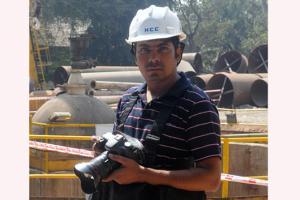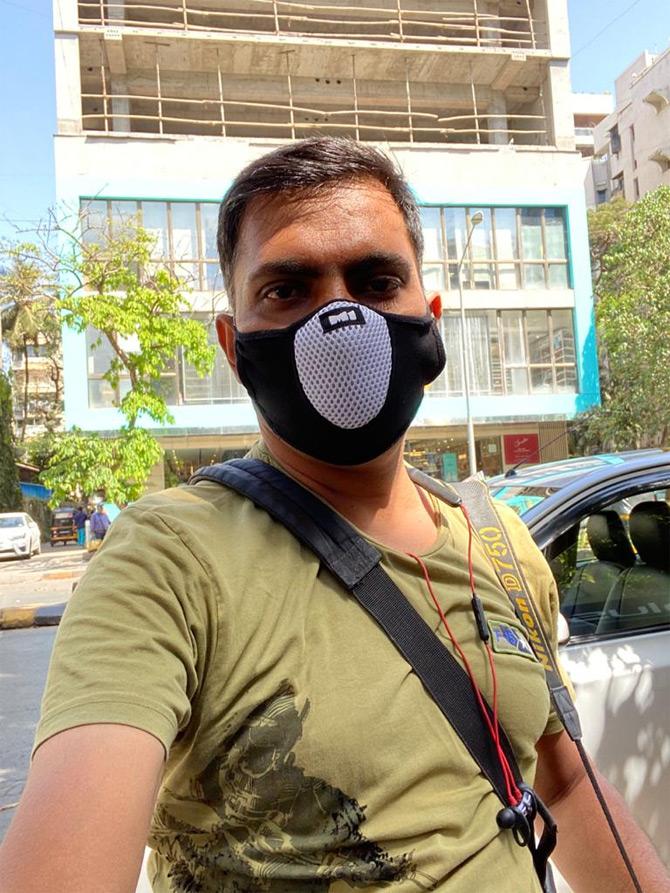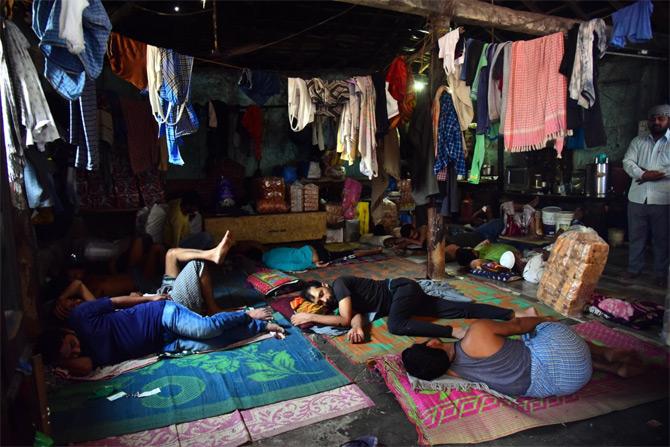mid-day photographer Shadab Khan talks about social distancing and the challenges of working during the pandemic in the first episode of 'Real Heroes of Coronavirus'

mid-day photpgrapher Shadab Khan talks about his experience while covering COVID-19 pandemic in Mumbai
![]() Mid-day online journalists interact with the frontline workers in a new series 'Real heroes of coronavirus'. Media photographers, reporters, railway staff and medical workers tell their stories of grit, determination and every-day challenges in times of the pandemic.
Mid-day online journalists interact with the frontline workers in a new series 'Real heroes of coronavirus'. Media photographers, reporters, railway staff and medical workers tell their stories of grit, determination and every-day challenges in times of the pandemic.
ADVERTISEMENT
Mid-day senior photographer Shadab Khan is out on the field capturing striking photos of people, health-workers, the police and the city as part of his daily assignment at a time when coronavirus pandemic is spreading rapidly in Mumbai and the entire nation is under lockdown.
We spoke to Shadab Khan about his work and what it's like to be a news photographer in times of pandemic.
Here's an excerpt from the interview.
How has the global pandemic impacted your work?
The coronavirus outbreak hasn't affected our work as such. Since we come under the essential service providers and ours is a field job, it's the same daily routine. The focus is more on pandemic photos as we visit sensetive areas and try to get pictures of people who may have broken lockdown rules and also capture shots of how the police are handling the situation. Nowadays, we also visit contaminated areas to get photos of medical staffs conducting COVID-19 tests and get visuals of the epidemic situation in Mumbai. For us, the work has only increased due to the outbreak of the global pandemic.
Nowadays, do you prepare yourself mentally before going out on assignments?
To be honest, there is no mental preparation as such. But I offer prayers five times a day and pray that I go safely and come back home safely. As a media-person, I also consume a lot of news and keep reading about the International guidelines laid down for photojournalists as to what precautions should be taken. I do this as it helps me to stay motivated in the fight against coronavirus. It is the first time that I am experiencing a pandemic which has changed our lives. I have never covered something like this ever before. Although I have covered riots and other sensetive events, a pandemic that takes place only once in 100 years is a different experience. I have been following international reports and guidelines to take precaution and prepare mentally to fight the COVID-19 crisis.

Shadab makes sure that his equipment, bag and mobile are sanitised in order to take precautions against COVID-19
How do you protect yourself?
Face mask, hand sanitisers and hand gloves are mandatory when I am leaving the house. With the increasing number of cases in Mumbai, we have to take extra precautions as our camera equipment is metal. While shooting, we are constantly handling the camera with our hands and our eyes are exposed when we are focusing to click the pictures. To ensure our safety, we sanitise the camera every two to three hours. Besides the equipment, I also sanitise my mobile phone with a spray sanitiser that I carry with me. After completimg a shooting assignment in a contaminated area, I make sure that the camera equipment is sanitised before keeping them in the bag.
Do you take any precaution while heading back home after doing on-field reporting?
Though it is risk to be outside during the pandemic, the real challenge begins when we get back home to be with our families. Since the outbreak of the coronavirus, I have isolated myself to another room and make sure that I maintain social distancing with my family members. While leaving for work and after coming back home, I don't hug my children. Since day one, I am practising self-quarantine to keep my family safe and away from any risk. Infact, I take more precautions at home than I do while I go out. The epidemic is so dangerous that one cannot be sure how the infection will strike.
During the COVID-19 coverage did you face scary moments? Which has been your scariest moment?
It is scary to visit crowded localities nowadays to cover the pandemic. In the beginning it was not a problem but since the police have imposed strict rules in these areas, we are facing issues. On few occasions, people in these localities have attacked and abused us, blaming the media for the strict police action. But all localities are not the same. We keep calm and ensure that we don't fight back or argue with the people when faced with a hostile situation. To ensure our own safety, we move out of the place quickly if we are confronted by the crowd.
Did you face challenges from the police while covering the COVID-19 pandemic?
In the beginning the police officials were not aware that the media comes under the essential services list and stopped us from entering certain areas which led to arguments sometimes. But gradually they understood and let us do our jobs. When they see the cameras and we show them our press cards, they ask us where we are going and all, that's it.
How is your department and the organisation supporting you?
We are getting the support of our department and the organisation in every possible way. I have been working in mid-day for 15 years and the organisation has been always supportive, our managers do not pressurise us for assignments. My reporting officer calls twice a day and inquires about my whereabouts and tells me to be extra careful while visiting contaminated zones and avoid going to sensitive areas frequently. We are always told to ensure safety first before work.

Shadab feels that practicing social distancing in Dharavi where people are cramped in small houses is nearly impossible
Although he covers different areas every day, Shadab makes it a point to visit a contaminated area at least once a day to check if any new development has taken place. Speaking about Dharavi, which has emerged as one of the biggest contaminated zones in Mumbai, Shadab said, "I visit Dharavi to see how the labourers are doing and how the small scale industries are coping with the COVID-19 epidemic"
"Everyone is talking about social distancing but it is not possible in Dharavi. Most houses in the locality are 8X8 small houses with 8 to 10 people cramped inside. In order to click a picture, one has to stand at the door and shoot, social distancing in areas such as Dharavi is almost impossible. The lanes in Dharavi are so narrow that if people are coming from the other side it is impossible to walk past them without making physical contact," added Shadab.
Besides Dharavi, Shadab carries out his photo assignments in Bandra, Sion and Wadala.
What is your message to the general public?
We are out on the roads because we have a responsibility as essential service providers. I would request people to stay home as far as possible. Only by staying home will you be safe! Follow the guidelines laid down by the government and maintain social distancing.
Catch up on all the latest Mumbai news, crime news, current affairs, and a complete guide from food to things to do and events across Mumbai. Also download the new mid-day Android and iOS apps to get latest updates.
Mid-Day is now on Telegram. Click here to join our channel (@middayinfomedialtd) and stay updated with the latest news
 Subscribe today by clicking the link and stay updated with the latest news!" Click here!
Subscribe today by clicking the link and stay updated with the latest news!" Click here!






